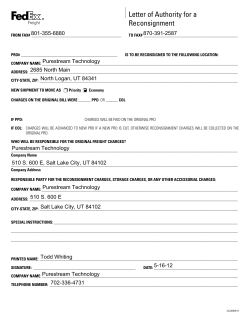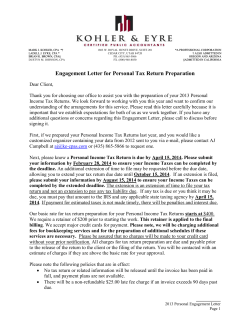
Experiment II – Electric Field
Experiment II – Electric Field The electric field, like the gravitational field, is an abstract representation of a force or interaction. In order to understand physical phenomena it is useful to develop a graphical representation of the electric field using electric field lines. Activity 1 The pictures below show the electric fields of two different point charges: one positive, one negative. The charge in the top drawing is a +2μC charge and that in the bottom is –5μC. The electric field is represented by the lines in these drawings. Write a rule describing the representation of electric fields by field lines in the box below. Consider in particular: 1. The direction of the lines as indicated by the arrows; 2. The places where lines start and end relative to the signs of the source charges; Electric Field II - 1 3. The separation or spacing between the lines in a particular region relative to the strength of the field; 4. The number of lines starting or ending on a charge relative to the magnitude and sign of the charge; and 5. The presence or absence of an electric field between the electric field lines. Next, consider the field lines of a configuration of two charges of equal magnitude but of opposite sign. This combination of charges is called an electric dipole. Check the rule that you developed about the representation of electric fields by field lines on the two-charge configuration. Make sure that your rule is consistent with each of the 5 points mentioned on the previous page. If necessary, write a revised version of your rule here: Electric Field II - 2 Activity 2 Predicting Electric Fields Now that we have developed some understanding of the rules for drawing electric fields, let’s attempt to sketch the fields of different charges. For each example be sure to follow your rules and do not forget to draw arrows indicating the direction of the field. The charges are located on the x-axis at the positions indicated. 1. Q1 = 2 μC at x = 0 and Q2 = 2 μC at x = 2 (sketch below) a. Is the electric field zero at x = 1, y = 0? Explain why or why not. b. Is the electric field zero at x = 1, y = 1? Explain why or why not. Electric Field II - 3 2. Q1 = 5 μC at x = 0, Q2 = 1 μC at x = 2 (sketch below) a. Is the electric field zero at x = 1, y = 0? Explain. b. Are there places on the x-axis where the electric field is zero? If so, determine the location(s). Instructor Initials: ___________________ Electric Field Date: __________ II - 4 Electric Field (1) Field lines. Draw arrows specifying the direction of the electric force on an electron placed at A, B or C. Use the length of the arrows to indicate the relative strength of the forces. (2) a) A C B Symmetry. Use symmetry to determine the direction of the electric field at the location indicated by the dot for each charge distribution (a-d). Note there is no charge at the dot; it just marks the location. +Q b) c) -Q -Q d) +2Q +Q +Q Worksheets 2 (3) Finding the electric field of a continuous charge distribution by direct integration. y a) A thin line charge. Find the y-component of the electric field E at point P due to the line charge. An integral table is provided. dx 2 2 x +a x dx 2 x +a 2 dx (x 2 (x 2 +a ) dx (x + b) ) = ) = 2 3/ 2 a = ln (x + b) + dx x +a 2 ((x + b ) +a ) 2 3/ 2 = +a ((x + b) 2 a 2 +a 2 = ( x + b )2 + a 2 (x + b ) ( x + b )2 + a 2 2 (x + b) dx −1 x +a 2 (x + b)2 + a 2 L 2 2 2 + a2 (x + b) dx x 2 2 (x + b) = x2 + a2 2 3/ 2 x dx +a ( = ln x + x 2 + a 2 +λ ) 2 3/ 2 = P x w −1 (x + b)2 + a 2 b) A thin semi-circle of charge. Find the electric field E at the center of the circle of which the semi-circle is a part. (Often, this is just phrased as “find the electric field at the center of the circle”, even if the charge distribution is not a full circle.) The circle has radius R and a charge density of -λ. -λ Worksheets 3
© Copyright 2025





















